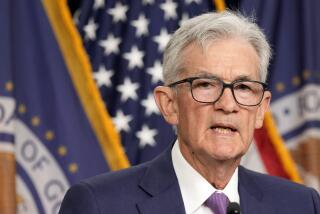Economy Has Reached ‘Soft Landing’ and There’s No Recession in Sight, Analysts Say
- Share via
WASHINGTON — The economy has reached the long-discussed “soft landing” and there’s no recession in sight, top analysts say.
The consensus in the latest surveys by the National Assn. of Business Economists and the newsletter Blue Chip Economic Indicators is that the economy will grow 2.9% this year and 2.4% in 1996.
“Out of 49 respondents, only one anticipates that a recession will begin this year,” the business economists said in releasing their survey results Monday. “Three more expect the next recession to begin sometime in 1996.”
None of the 52 Blue Chip forecasters sees a recession coming in either year.
The term soft landing is often used to describe an economy slowing sufficiently to keep inflation in check but without stalling into a recession.
That was the Federal Reserve Board’s goal as it boosted short-term interest rates seven times during the 15 months ended in February.
But after the economy slowed almost to a stop in the spring, and because there were no serious inflation pressures on the horizon, the central bank notched rates down slightly in July.
A third group, the Shadow Open Market Committee, a panel of economists that closely follows Fed policies, said a recession could come next year unless there is another cut in interest rates.
“The Fed has remained too tight too long,” said Allen Meltzer of Carnegie-Mellon University. He said a prime measure of the money supply is growing at a 4.5% annual rate and that it should be expanding at 6%.
The business economists conducted their survey in August. The results were released at the association’s annual meeting in San Francisco and made available in Washington. The Blue Chip poll of 52 forecasters was taken earlier this month.
The two polls produced identical readings on inflation--3% this year and 3.2% in 1996. The consumer price index rose 2.7% in 1994.
They also showed similar feelings about unemployment prospects.
The business economists’ consensus calls for the jobless rate to fall to average 5.7% this year, down from 6.1% in 1994, before edging up to 5.9% next year.
The consensus in the Sedona, Ariz., newsletter survey sees unemployment of 5.7% this year and 5.8% in 1996.
The business economists’ forecast of 2.9% economic growth this year is less than the 3.2% consensus in the association’s previous survey in May, although the latest forecast for 1996 sees it as a bit stronger than the earlier 2.2%.
Economic growth slowed from a 5.1% annual rate in the fourth quarter of 1994 to 2.7% in the first quarter of 1995 and just 1.1% in the second.
The April-June growth rate is the slowest since the economy expanded at a barely perceptible 0.1% rate in the last three months of 1991. The business economists’ forecasters predict it will be the weakest of the year.
Contributing to economic growth this year will be business investments in new plants and equipment, forecast to rise 14.3%, and consumer spending, up 2.7%.
But the forecasters expect other components to decline: residential expenditures, down 3.5%; government spending, down 0.2%; inventories, down $17.5 billion, and net exports, down $10 billion.
The business economists predict a different growth composition next year.
“Growth in business fixed investment is projected to drop into single digits (5.6%) for the first time since 1992,” the association said. “Growth in consumption (2.3%) will again about match the performance of the overall economy.
“Modest gains, rather than declines, will be posted by residential investment (0.7%) and by government purchases (0.4%), while net exports are expected to rebound strongly, improving by $13 billion,” it added.
Finally, the forecasters believe businesses will continue to trim their inventories through much of 1996, paring another $9 billion worth of goods from shelves and back lots.
More to Read
Inside the business of entertainment
The Wide Shot brings you news, analysis and insights on everything from streaming wars to production — and what it all means for the future.
You may occasionally receive promotional content from the Los Angeles Times.










